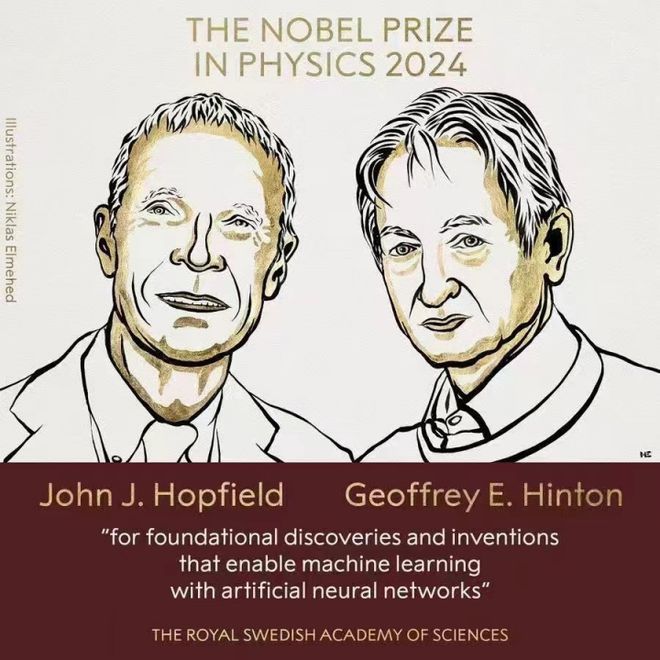
AI Pioneer ទទួលបានរង្វាន់ណូបែលរូបវិទ្យាឆ្នាំ 2024

រង្វាន់ណូបែលរូបវិទ្យាឆ្នាំ 2024 ត្រូវបានប្រកាស។ គណៈកម្មាធិការរង្វាន់ណូបែលរូបវិទ្យាបានផ្តល់រង្វាន់ដល់លោក John Hopfield មកពីសហរដ្ឋអាមេរិក និងលោក Geoffrey Hinton មកពីសាកលវិទ្យាល័យ Toronto ប្រទេសកាណាដា សម្រាប់ “ការរកឃើញជាមូលដ្ឋាន និងការច្នៃប្រឌិតរបស់ពួកគេក្នុងការរៀនម៉ាស៊ីនដោយផ្អែកលើបណ្តាញសរសៃប្រសាទសិប្បនិម្មិត” ។
ជ័យលាភីទាំងពីរបាននិងកំពុងធ្វើការងារសំខាន់ៗទាក់ទងនឹងបណ្តាញសរសៃប្រសាទ និងរូបវិទ្យាតាំងពីទសវត្សរ៍ឆ្នាំ 1980 ។ ពួកគេនឹងចែករំលែករង្វាន់ចំនួន 11 លានក្រូនស៊ុយអែត។
គណៈកម្មាធិការបាននិយាយថា “ពួកគេបានបង្កើតបច្ចេកទេសដើម្បីដំណើរការព័ត៌មានដោយប្រើរចនាសម្ព័ន្ធបណ្តាញដោយអនុវត្តគោលគំនិត និងវិធីសាស្រ្តជាមូលដ្ឋានពីរូបវិទ្យា។ នេះនាំឱ្យមានការអភិវឌ្ឍន៍យ៉ាងខ្លាំងក្នុងការរៀនម៉ាស៊ីនក្នុងរយៈពេលម្ភៃឆ្នាំកន្លងមកនេះ”។
John Hopfield ត្រូវបានគេទទួលស្គាល់សម្រាប់ការបង្កើតអង្គចងចាំរួមមួយដែលអាចរក្សាទុកនិងបង្កើតរូបភាពឡើងវិញនិងប្រភេទផ្សេងទៀតនៃរចនាសម្ព័ន្ធទិន្នន័យ។ នៅពេលដែលរូបភាពដែលខូច ឬមិនពេញលេញត្រូវបានបញ្ចូលទៅក្នុងបណ្តាញ Hopfield វាដំណើរការជាប្រព័ន្ធនូវថ្នាំង និងធ្វើបច្ចុប្បន្នភាពតម្លៃរបស់វា ដោយហេតុនេះកាត់បន្ថយថាមពលនៃបណ្តាញ។ ជាលទ្ធផល បណ្តាញស្វែងរកបន្តិចម្តងៗនូវរូបភាពដែលបានរក្សាទុកដែលស្រដៀងនឹងរូបភាពបញ្ចូលមិនល្អឥតខ្ចោះបំផុត។
Geoffrey Hinton បានបង្កើតឡើងនៅលើបណ្តាញ Hopfield ដើម្បីបង្កើតបណ្តាញថ្មីមួយហៅថាម៉ាស៊ីន Boltzmann ដែលអាចរៀនស្គាល់ធាតុលក្ខណៈពិសេសនៅក្នុងប្រភេទទិន្នន័យដែលបានផ្តល់ឱ្យ។ ម៉ាស៊ីននេះត្រូវបានបណ្តុះបណ្តាលដោយការបញ្ចូលឧទាហរណ៍ដែលទំនងជាកើតឡើងក្នុងអំឡុងពេលប្រតិបត្តិការរបស់វា។ ម៉ាស៊ីន Boltzmann អាចត្រូវបានប្រើសម្រាប់ការចាត់ថ្នាក់រូបភាព ឬបង្កើតឧទាហរណ៍ថ្មីនៃប្រភេទដែលវាត្រូវបានបណ្តុះបណ្តាល។
លោកស្រី Ellen Moons ប្រធានគណៈកម្មាធិការរង្វាន់រូបវិទ្យាណូបែល បាននិយាយថា “ការងាររបស់អ្នកឈ្នះរង្វាន់បានផ្តល់នូវអត្ថប្រយោជន៍យ៉ាងច្រើន។ ក្នុងវិស័យរូបវិទ្យា យើងកំពុងអនុវត្តបណ្តាញប្រសាទសិប្បនិម្មិតនៅទូទាំងតំបន់ជាច្រើន ដូចជាការបង្កើតសម្ភារៈថ្មីដែលមានលក្ខណៈសម្បត្តិជាក់លាក់។
Moons បានបន្ថែមថា “មនុស្សជាតិមានទំនួលខុសត្រូវក្នុងការប្រើប្រាស់បច្ចេកវិទ្យាថ្មីនេះដោយសុវត្ថិភាព និងប្រកបដោយក្រមសីលធម៌ ដើម្បីទទួលបានអត្ថប្រយោជន៍ជាអតិបរមាសម្រាប់មនុស្សជាតិ”។
ជាការឆ្លើយតបទៅនឹងសារៈសំខាន់នៃការស្រាវជ្រាវបច្ចេកវិទ្យានេះ លោក Hinton បានកត់សម្គាល់ថា បញ្ញាសិប្បនិមិត្តនឹងមានឥទ្ធិពលយ៉ាងខ្លាំងលើសង្គមរបស់យើង ប្រៀបធៀបទៅនឹងបដិវត្តន៍ឧស្សាហកម្ម។ ទោះជាយ៉ាងណាក៏ដោយ លោកបានកត់សម្គាល់ថា វានឹងមិនលើសមនុស្សលើរាងកាយនោះទេ ប៉ុន្តែផ្ទុយទៅវិញគឺបញ្ញា។ “យើងមិនដែលជួបប្រទះអ្វីដែលឆ្លាតជាងខ្លួនយើងទេ”
The 2024 Nobel Prize in Physics has been announced. The Nobel Physics Prize Committee awarded John Hopfield from the United States and Geoffrey Hinton from the University of Toronto, Canada, for their “fundamental discoveries and inventions in machine learning based on artificial neural networks.”
Both laureates have been conducting significant work related to neural networks and physics since the 1980s. They will share a prize of 11 million Swedish kronor.
The committee stated, “They developed techniques to process information using network structures by applying fundamental concepts and methods from physics. This led to an explosive development in machine learning over the past twenty years.”
John Hopfield is recognized for inventing an associative memory that can store and reconstruct images and other types of data structures. When distorted or incomplete images are input into the Hopfield network, it systematically processes nodes and updates their values, thereby reducing the energy of the network. As a result, the network gradually finds the stored image that is most similar to the imperfect input image.
Geoffrey Hinton built upon the Hopfield network to create a new network called the Boltzmann machine, which can learn to recognize feature elements within a given type of data. This machine is trained by inputting examples that are likely to occur during its operation. The Boltzmann machine can be used for classifying images or generating new examples of the types it has been trained on.
Ellen Moons, the chair of the Nobel Physics Prize Committee, stated, “The work of the laureates has produced tremendous benefits. In the field of physics, we are applying artificial neural networks across a wide range of areas, such as developing new materials with specific properties.”
Moons added, “Humanity has the responsibility to use this new technology safely and ethically to maximize its benefits for humanity.”
In response to the significance of researching this technology, Hinton remarked that artificial intelligence will have a profound impact on our society, comparable to the Industrial Revolution. However, he noted that it will not surpass humans physically, but rather intellectually. “We have never experienced something smarter than ourselves.”
